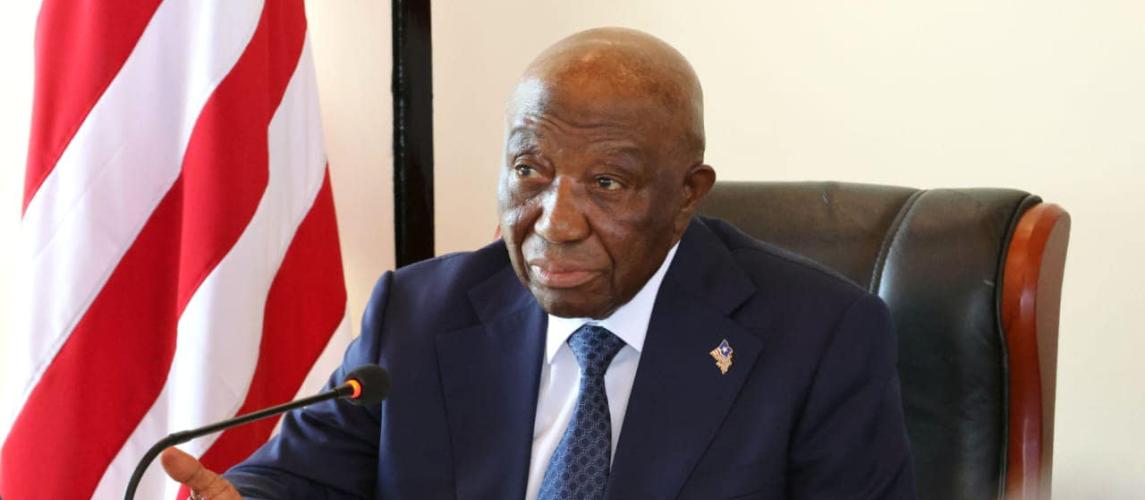Monrovia, Liberia – President Joseph Nyuma Boakai has reaffirmed his administration’s vision to transform Liberia into the Atlantic gateway for its landlocked neighbors through a massive infrastructure initiative known as the Liberty Corridor.
Speaking at a high-level event at the EJS Ministerial Complex, where he also launched the Youth Entrepreneurship Investment Bank (YEIB) and honored African Development Bank (AfDB) President Dr. Akinwumi Adesina, Boakai said the Liberty Corridor is central to Liberia’s regional economic and diplomatic ambitions.
“This project is about shared prosperity,” Boakai said. “But we would also love to play the role of gateway—helping our neighbors like Guinea, Burkina Faso, and Mali reach the Atlantic.”
A Pathway to Prosperity and Regional Trade
The Liberty Corridor is not just a dream. It’s already in motion. At its core is a historic Bilateral Implementation Agreement between Liberia and Guinea, signed in 2019, which allows Guinean iron ore to pass through Liberia’s Yekepa-to-Buchanan railway and port system. This agreement has laid the groundwork for a new multibillion-dollar partnership with U.S.-owned Ivanhoe Atlantic.
Under the deal, iron ore from Guinea’s Kon Kweni project will be transported via Liberia. Even more ambitious, the plan includes a Green Steel plant in Guinea—aligned with global clean energy goals—that will process high-grade ore locally, adding value before export and creating jobs across borders.
Earlier this month, Ivanhoe executives met with Guinea’s Prime Minister Amadou Oury Bah to move the project forward, reinforcing Guinea’s commitment to the shared infrastructure vision.
Liberia stands to benefit massively: of the 12 billion tons of iron ore mapped in the corridor, about 7 billion are located inside Liberia.
Billions on the Table, Jobs on the Horizon
In early 2025, Liberia’s Inter-Ministerial Concessions Committee (IMCC) signed a landmark US$1.8 billion Concession and Access Agreement with Ivanhoe Atlantic. Once approved by the Legislature, the deal could deliver:
- US$1.4 billion in rail access fees
- US$600 million in taxes
- US$175 million in direct support to counties (Nimba, Bong, Grand Bassa)
- US$25 million in upfront payments
- US$37 million already paid under a prior agreement
These figures highlight the scale of potential impact—not just in revenue, but in transforming Liberia into a logistics and trade powerhouse.
Ending the Monopoly: A New Rail Era
Boakai’s Executive Order 136 also set up the National Rail Authority, a key reform body that ends ArcelorMittal Liberia’s exclusive control over the Yekepa-Buchanan rail line. Now, multiple operators will have access, unlocking new possibilities in mining, agriculture, and freight transport.
This multi-user rail policy paves the way for broader investment and fairer use of national infrastructure.
Inspired by Africa, Powered by Youth
Boakai likened the Liberty Corridor to the U.S.-backed Lobito Corridor in Southern Africa, which links Angola, DRC, and Zambia for trade and mining integration. Like Lobito, the Liberty Corridor aims to merge transport, mining, and industrial development into a single growth engine for West Africa.
At the same event, Boakai launched the Liberia Youth Entrepreneurship Investment Bank (YEIB), part of his ARREST Agenda. The YEIB will provide young Liberians with the financing, skills training, and mentorship needed to become job creators, not just job seekers.
Gratitude to AfDB and a Vision for Tomorrow
Boakai praised the African Development Bank for its ongoing support, with a portfolio of US$408 million across 18 projects in infrastructure, agriculture, finance, and governance. He credited the AfDB for helping to rebuild public trust and boost institutional capacity.
“This corridor is more than infrastructure—it’s our pathway to inclusive growth and stronger ties with our neighbors,” Boakai said.
As the Liberty Corridor gains momentum and the Ivanhoe deal heads to the Legislature, President Boakai’s message is clear: Liberia is open for business, ready to lead, and prepared to connect West Africa to the world.


